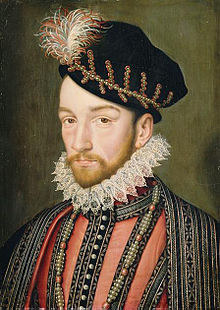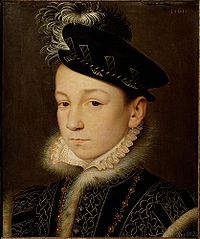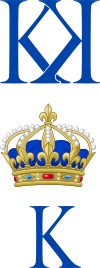- Charles IX of France
-
Charles IX 
Charles IX around 1572, painted by François Clouet. King of France Reign 5 December 1560 – 30 May 1574 Coronation 15 May 1561 Predecessor Francis II Successor Henry III Regent Catherine de' Medici (until 1563) Spouse Elisabeth of Austria Issue Marie Elisabeth of Valois
Charles, Duke of Angoulême (illegitimate)House House of Valois Father Henry II of France Mother Catherine de' Medici Born 27 June 1550
Saint-Germain-en-Laye, FranceDied 30 May 1574 (aged 23)
Vincennes, FranceCharles IX (27 June 1550 – 30 May 1574) was King of France, ruling from 1560 until his death. His reign was dominated by the Wars of Religion. He is best known as king at the time of the St. Bartholomew's Day Massacre.
Contents
Life
Childhood
He was born Charles Maximilian, third son of King Henry II of France and Catherine de' Medici in the royal chateau of Saint-Germain-en-Laye. He was immediately made Duke of Orléans upon his birth, succeeding his older brother Louis, his father's second son who had died in infancy the year before.[1]
He[when?] visited England and on 14 May was made a Knight of the Order of the Garter at St. George's Chapel, Windsor Castle, along with Francis Russell, 2nd Earl of Bedford and Sir Henry Sidney.[citation needed]
Accession to the throne
His father died in 1559, followed in December 1560 by his elder brother, King Francis II (1544–1560). The ten-year-old Charles was immediately proclaimed King and, on 15 May 1561, consecrated as King of France in the cathedral at Reims. Government was dominated by his mother, Catherine de' Medici, who at first acted as regent for her young son. Antoine of Bourbon, himself in line to the French throne and husband to Queen Joan III of Navarre, was appointed Lieutenant-General of France.
First war of religion
Charles' reign was dominated by the Wars of Religion, which pitted various factions against each other. The Huguenots, the French adherents of Calvinism, had a considerable following among the nobility, while their enemies, later organised into the Catholic League were led by the House of Guise, a cadet branch of the House of Lorraine. Queen Catherine, though nominally a Catholic, tried to steer a middle course between the two factions, attempting to keep (or restore) the peace and augment royal power.
The factions had engaged in violence even before Charles' accession: a group of Huguenot nobles at Amboise had tried to abduct King Francis II and arrest the Catholic leaders – Francis, Duke of Guise and his brother, the Cardinal of Lorraine, followed by cases of Protestant iconoclasm and Catholic reprisals.[2] The regent tried to foster reconciliation at the colloquy at Poissy and, after that failed, made several concessions to the Huguenots in the Edict of Saint-Germain in January 1562,[3] but war began when some retainers of the House of Guise – hoping to avenge the attempt of Amboise – attacked and killed or wounded over 100 Huguenot worshipers at Vassy.
Louis of Bourbon, Prince of Conde, brother to the Lieutenant-General and the suspected architect of the Amboise conspiracy, had already prepared for war and, taking Vassy as the occasion, assumed the role of a protector of Protestantism and began to seize and garrison strategic towns along the Loire Valley. In return, the monarchy revoked the concessions given to the Huguenots. After the military leaders of both sides were either killed or captured in the battles at Rouen, Dreux and Orléans, the regent mediated a truce and issued the Edict of Amboise (1563).[4]
Armed peace
French Monarchy-
Capetian Dynasty, House of Valois
(Valois-Angoulême branch)Francis I Children Francis, Dauphin of Viennois Henry II Magdalene, Queen of Scots Charles of Valois Margaret, Duchess of Savoy Henry II Children Francis II Elizabeth, Queen of Spain Claude, Duchess of Lorraine Charles IX Henry III Margaret, Queen of Navarre Francis, Duke of Anjou Joan of Valois Victoria of Valois Francis II Charles IX Henry III The war was followed by four years of an uneasy "armed peace", during which Catherine tried to unite the factions in the successful effort to recapture Le Havre from the English. After this victory, Charles declared his legal majority in August 1563, formally ending the regency. However, Catherine would continue to play a principal role in politics and often dominate her son. In March of 1564, the King and his mother set out from Fontainebleau on a tour of the war-torn kingdom. Their tour spanned two years and brought them through Bar, Lyon, Salon – where they visited Nostradamus, Carcassonne, Toulouse – where the King and his younger brother Henry were confirmed —, Bayonne, La Rochelle and Moulins. During this trip, Charles IX issued the Edict of Roussillon, which standardised 1 January as the first day of the year throughout France.
Second and third war of religion
War again broke out in 1567 after reports of iconoclasm in Flanders prompted Charles to support Catholics there. Huguenots, fearing a Catholic attack was imminent, tried to abduct the King at Meaux, seized various cities and massacred Catholics at Nîmes. After the Battle of Saint-Denis saw both a Huguenot defeat and the death of the royal commander-in-chief, the short war ended in 1568 with another truce. However, the significant privileges granted to Protestants were widely opposed, leading to their cancellation and the resumption of war, in which the Dutch Republic, England and Navarre intervened on the Protestant side, while Spain, Tuscany and Pope Pius V supporting the Catholics. Finally, the royal debt and the King's desire to seek a peaceful solution in August 1570 led to yet another truce, which again gave concessions to the Huguenots.[5]
Marriage and children
On 26 November 1570 Charles married Elisabeth of Austria,[6] with whom he fathered one daughter, Marie Elisabeth of Valois (1572–1578). In 1573, Charles fathered an illegitimate son, Charles, Duke of Angoulême, with his mistress, Marie Touchet.[7]
Coligny's ascendancy and the massacre
After the Peace of Saint-Germain in 1570, the King increasingly came under the influence of Admiral Gaspard de Coligny, who during the war had succeeded the slain Prince of Condé as leader of Huguenots. The Queen Mother, however, became increasingly fearful of Coligny's unchecked power, especially since the Admiral was pursuing an alliance with England and the Dutch. Coligny was also hated by Henry, Duke of Guise, who accused the Admiral of having ordered the assassination of his father during the siege of Orléans in 1562.
During the peace settlement, a marriage had been arranged between Charles' sister Margaret (1553–1615) and Henry de Bourbon, heir to the throne of Navarre, and one of the leading Huguenots. Many Huguenot nobles, including Admiral de Coligny, thronged into Paris for the wedding, which was set for 18 August 1572. On 22 August, a failed attempt on Coligny's life—the originator of which remains unclear—put the city in a state of apprehension, as both visiting Huguenots and Parisian Catholics feared an attack by the other side.
In this situation, in the early morning of 24 August 1572, the Duke of Guise moved to avenge his father and murdered Coligny in his lodgings. As Coligny's body was thrown into the street, Parisians mutilated the body and then erupted into a full-scale massacre of Huguenots, which was to last five days. Henry of Navarre managed to avoid death by pledging to convert to Catholicism. Over the next few weeks the disorder spread to more cities across France. In total, up to 10,000 Huguenots were killed in Paris and the provinces.[8]
Though the massacres severely weakened Huguenot power, it also reignited war, which ceased after the Edict of Boulogne in 1573 granted Huguenots amnesty and limited religious freedom. However, 1574 saw a failed Huguenot coup at Saint-Germain and successful Huguenot uprisings in Normandy, Poitou and the Rhône valley, setting the stage for another round of war.[9]
Decline and death
Having witnessed the horrors of a massacre he had neither approved of nor predicted, the King's fragile mental and physical constitution drastically weakened. His moods swung from boasting about the extremity of the massacre to exclamations that the screams of the murdered Huguenots kept ringing in his ears. Frantically, he blamed alternately himself – "What blood shed! What murders! he cried to his nurse. What evil council I have followed! O my God, forgive me... I am lost! I am lost!" – or his mother – "Who but you is the cause of all of this? God's blood, you are the cause of it all!" The Queen-mother responded by declaring she had a lunatic for a son.[10]
His physical condition, tending towards tuberculosis, deteriorated to the point where, by spring of 1574, the hoarse coughing turned bloody and the hemorrhages grew more violent.
On his last day, 30 May, Charles called for Henry of Navarre, embraced him, and said, "Brother, you are losing a good friend. Had I believed all that I was told, you would not be alive. But I always loved you... I trust you alone to look after my wife and son. Pray God for me. Farewell."[11]
Charles IX died on 30 May at the Château de Vincennes, aged twenty-three years. As his younger brother, Henry, Duke of Anjou had recently been elected King of Poland and was away from France, their mother Catherine resumed the regency until Henry's return from Poland.[12]
Book on hunting
Charles had an interest in hunting, and he wrote a book on the subject, La Chasse Royale, which was published long after his death, in 1625. It is a valuable source for those interested in the history of hounds and hunting.[13]
In fiction
Charles IX is a supporting character in Alexandre Dumas' historical novel Queen Margot, which focuses on the marriage between Henry of Navarre and Margaret of Valois. The book depicts Charles as a frail and sickly ruler, who is complicit in the massacres engineered by his mother and dies after reading a book poisoned with arsenic, which his mother intended for Henry of Navarre.
Ancestors
Ancestors of Charles IX of France John, Count of Angoulême Charles, Count of Angoulême Marguerite de Rohan Francis I of France Philip II, Duke of Savoy Louise of Savoy Margaret of Bourbon Henry II of France Charles I de Valois, Duke of Orléans Louis XII of France Marie of Cleves Claude of France Francis II, Duke of Brittany Anne, Duchess of Brittany Margaret of Foix Charles IX of France Lorenzo de' Medici Piero di Lorenzo de' Medici Clarissa Orsini Lorenzo II de' Medici, Duke of Urbino Roberto Orsini, Count of Tagliacozzo Alfonsina Orsini Caterina Sanseverino Catherine de Medici Bertrand VI of Auvergne John III, Count of Auvergne Louise de la Tremoille Madeleine de la Tour d'Auvergne Jean VIII, Count of Vendôme Jeanne de Bourbon-Vendôme Isabelle de Beauveau Notes
- ^ Heritier, p. 48; Frieda, p. 69.
- ^ Salmon, p. 124–137. Sutherland, p. 111–138.
- ^ Knecht, p. 78-79.
- ^ Knecht, p. 86.
- ^ Jouanna et al., p. 181-185; Knecht, p. 151.
- ^ Saint-Amand/Martin, p. 245.
- ^ Saint-Amand/Martin, p. 282.
- ^ Jouanna et al., 196–204.
- ^ Jouanna et al., p. 213; Knecht, p. 181.
- ^ Durant, p. 355.
- ^ Guizot, p. 415.
- ^ Knecht, p. 190.
- ^ Charles IX, La Chasse Royale (1625).
References
- Durant, Will (1961). The Age of Reason. VII. Simon and Schuster.
- Frieda, Leonie (2003). Catherine de Medici. New York: Harper Collins. ISBN 0060744928.
- Guizot, F. (1887). The History of France. III. London.
- Heritier, Jean (1963). Catherine de Medici. London: George Allen and Unwin.
- Jouanna, Arlette; Boucher, Jacqueline; Biloghi, Dominique; Thiec, Guy (1998). Histoire et dictionnaire des Guerres de religion. Collection Bouquins. Paris: Laffont. ISBN 2221074254.
- Knecht, Robert J. (2000). The French Civil Wars. Modern Wars in Perspective. Harlow: Longman. ISBN 0582095492.
- Saint-Amand, Imbert de; Martin, Elizabeth Gilbert (1893). Women of the Valois court. Charles Scribner's Sons.
- Salmon, J. H. M. (1975). Society in Crisis: France in the Sixteenth Century. London: Methuen. ISBN 0416730507.
- Sutherland, N. M. (1962). "Calvinism and the conspiracy of Amboise". History 47 (160): 111–138. doi:10.1111/j.1468-229X.1962.tb01083.x.
Titles
Charles IX of FranceBorn: 27 June 1550 Died: 30 May 1574Regnal titles Preceded by
Francis IIKing of France
5 December 1560 – 30 May 1574Succeeded by
Henry IIIFrench royalty Preceded by
Francis, Dauphin of FranceHeir to the Throne
as Heir presumptive
10 July 1559 – 5 December 1560Succeeded by
Henry, Duke of AnjouFrench nobility Preceded by
Francis II of FranceCount of Provence and Forcalquier
as Charles V
5 December 1560 – 30 May 1574Succeeded by
Henry III of FranceDauphin of Viennois, Count of Valentinois and Diois
5 December 1560 – 30 May 1574Preceded by
Louis IIIDuke of Orléans
27 June 1550 – 5 December 1560Succeeded by
Henry IIIDukes of Orléans Philippe · Louis · Charles · Louis · Henri · Charles · Louis · Charles Maximilian · Alexandre Édouard · Nicolas Henri · Gaston · Philippe · Philippe · Louis · Louis Philippe · Louis Philippe Joseph · Louis Philippe · Ferdinand Philippe · Philippe · François Currant claimants Jacques List of French monarchs Merovingians
(481–751)Clovis Ist (481–511) • Chlothar I (511–561) • Charibert I (561–567) • Guntram (561–593) • Chilperic I (561–584) • Sigebert I (561–575) • Chlothar II (584–629) • Dagobert I (629–639) • Sigebert II (639–656) • Clovis II (639–657) • Chlothar III (657–673) • Theuderic III (673–691) • Clovis III (691–695) • Childebert III (695–711) • Dagobert III (711–715) • Chilperic II (715–721) • Chlothar IV (717–719) • Thierry IV (721–737) • Childeric III (737–751)Carolingians
(843–888, 898–922, 936–987)Pepin III (751–768) • Carloman I (768–771) • Charlemagne (768–814) • Louis I (814–840) • Charles I (843–877) • Louis II (877–879) • Louis III (879–882) • Carloman II (879–884) • Charles II (885–888) • Charles III (898–922) • Louis IV (936–954) • Lothair IV (954–986) • Louis V (986–987)Robertians
(888–898, 922–923)Eudes of Paris (888–898) • Robert I (922–923)Bosonids
(923–936)House of Capet
(987–1328)Hugh (987–996) • Robert II (996–1031) • Henry I (1031–1060) • Philip I (1060–1108) • Louis VI (1108–1137) • Louis VII (1137–1180) • Philip II (1180–1223) • Louis VIII (1223–1226) • Louis IX (1226–1270) • Philip III (1270–1285) • Philip IV (1285–1314) • Louis X (1314–1316) • John I (1316) • Philip V (1316–1322) • Charles IV (1322–1328)House of Valois
(1328–1498)Philip VI (1328–1350) • John II (1350–1364) • Charles V (1364–1380) • Charles VI (1380–1422) • Charles VII (1422–1461) • Louis XI (1461–1483) • Charles VIII (1483–1498)House of Valois-Orléans
(1498–1515)House of Valois-Angoulême
(1515–1589)Francis I (1515–1547) • Henry II (1547–1559) • Francis II (1559–1560) • Charles IX (1560–1574) • Henry III (1574–1589)House of Bourbon
(1589–1792)Henry IV (1589–1610) • Louis XIII (1610–1643) • Louis XIV (1643–1715) • Louis XV (1715–1774) • Louis XVI (1774–1792) • Louis XVII (claimant, 1792–1795)House of Bonaparte
First Empire (1804–1814, 1815)Napoleon I (1804–1814, 1815) • Napoleon II (1815)House of Bourbon
Bourbon Restoration
(1814, 1815–1830)House of Orléans
July Monarchy (1830–1848)Louis Philippe I (1830–1848)House of Bonaparte
Second Empire (1852–1870)Categories:- Roman Catholic monarchs
- House of Valois-Angoulême
- Kings of France
- Dauphins of Viennois
- Dauphins of France
- Knights of the Garter
- Knights of the Golden Fleece
- People of the French Wars of Religion
- Modern child rulers
- 1550 births
- 1574 deaths
- People from Saint-Germain-en-Laye
- Heirs presumptive to the French throne
- 16th-century French people
Wikimedia Foundation. 2010.






